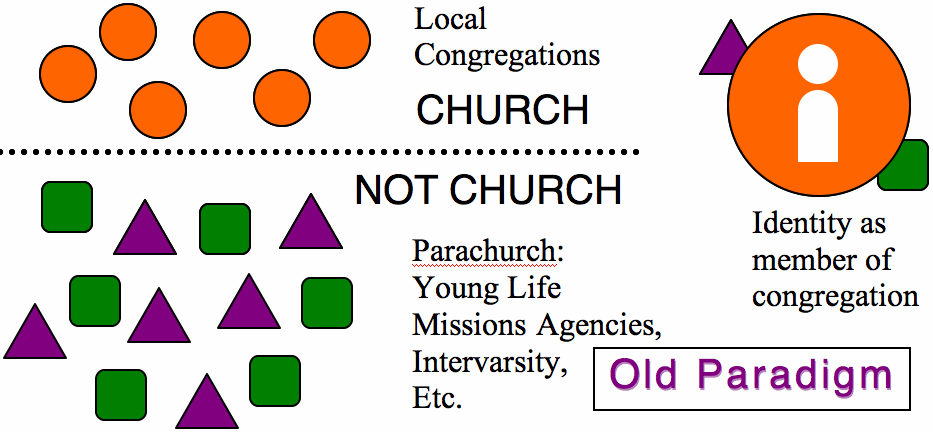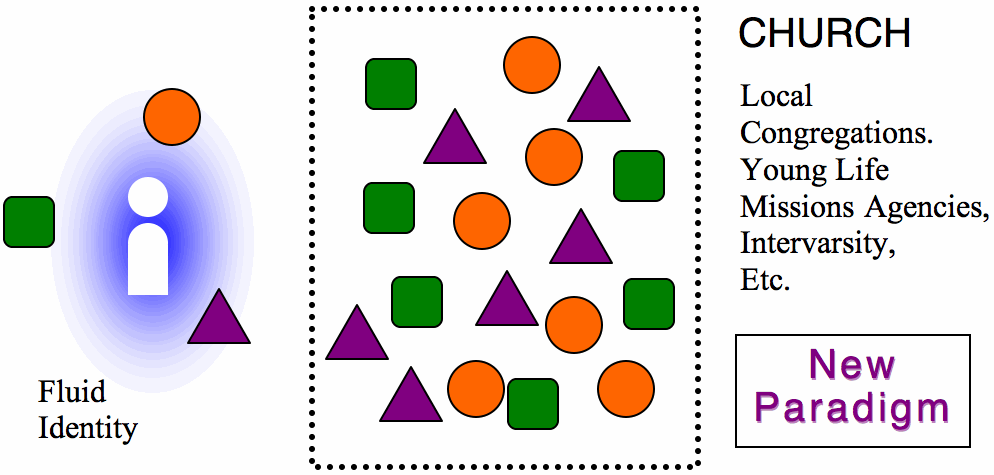Shortly after writing the Cross-cultural Impact article on Expressions of Church, I was intrigued to read the following comment by Peter Shaukat in a Catalyst Interchange posting:
I think there is a critical need in a larger theological/ missiological sense to rethink what we mean by church. There is a growing understanding that the church is much bigger than the local congregation, and that the church is a much more multi-faceted reality. Mission agencies and the business community should not be conceived as separate entities but as a part of the church. What we are seeing emerge are affinity groups—like the business community—that don’t capture the full orbed expression of the church, but neither does the local congregation at the corner of State and Main.1
 The implication is that local congregations,2 while being important expressions of the body of Christ, cannot claim exclusive rights as the only organization that fulfills the biblical description of church. Moreover, missions agencies and other “parachurch” Christian organizations, while not calling themselves “church,” provide important and legitimate expressions of what it means to be the people of God. This moves away from a traditional identification of “church” according to organizational criteria – constitutions, positions of leadership, buildings, etc. – to embrace a more functional view of “church” in which believers come together for Jesus’ kingdom purposes.
The implication is that local congregations,2 while being important expressions of the body of Christ, cannot claim exclusive rights as the only organization that fulfills the biblical description of church. Moreover, missions agencies and other “parachurch” Christian organizations, while not calling themselves “church,” provide important and legitimate expressions of what it means to be the people of God. This moves away from a traditional identification of “church” according to organizational criteria – constitutions, positions of leadership, buildings, etc. – to embrace a more functional view of “church” in which believers come together for Jesus’ kingdom purposes.
The trend of fluid connections to church
In his book, Revolution,3 research guru George Barna observes that many young believers are experiencing “church” in a variety of non-traditional ways. There appears to be a pendulum shift away from the denominational and church loyalties of a few decades ago. The local congregation is no longer the default expression of “church,” but one of a number of options. The evangelical ecumenical movement has not only resulted in believers moving comfortably from church to church, but also with many living as fulfilled believers outside of traditional church organizations. Loyalties are not directed towards a particular organization, but towards a group of friends with whom they relate on a spiritual level for worship, teaching or service.
they view relationships as their church
We have seen this trend within our own home. Our daughter and youngest son are involved in Young Life Canada, a parachurch organization focused on building relationships with teens who do not know Christ as well as mentoring young people into leadership positions. At the same time, they take advantage of opportunities for significant relationships and worship experiences in other venues apart from Young Life. The important point is that they view these relationships as their “church” and do not sense a need to commit to a traditional expression of church.
Why fluid connections are good – and bad
 This trend is both unsettling and liberating. It is liberating because many believers are looking for significant expressions of their faith beyond those commonly available through the local church. An assumption among many loyal church goers is that true believers should belong to a traditional expression of church. But if Shaukat and Barna are correct, that is not the only option. While many still gravitate to the traditional local church (our oldest son is an example), there are still others who find connections with believers in a variety of contexts that provide them with significance, discipleship and Christian service in God’s kingdom. Even if someone does identify with a local congregation, they may be more committed to other ministries and organizations because of the perceived significance of what is being accomplished, and this limits their participation in their local church.
This trend is both unsettling and liberating. It is liberating because many believers are looking for significant expressions of their faith beyond those commonly available through the local church. An assumption among many loyal church goers is that true believers should belong to a traditional expression of church. But if Shaukat and Barna are correct, that is not the only option. While many still gravitate to the traditional local church (our oldest son is an example), there are still others who find connections with believers in a variety of contexts that provide them with significance, discipleship and Christian service in God’s kingdom. Even if someone does identify with a local congregation, they may be more committed to other ministries and organizations because of the perceived significance of what is being accomplished, and this limits their participation in their local church.
But it is unsettling because when those involved in “parachurch” ministries need to transition into other expressions of church that fit with their changing orientation and position in life, they may fail to do so. Many of these organizations are focused on a particular age or interest group and this leads to temporary rather than permanent participation. The individual covenant to Christ continues, but the identification with a particular group can be short-lived. Once involvement in an organization is finished, they may not transition to another ministry or a local congregation. Friends of our daughter are an example of this perspective: while both are committed followers of Christ, their sporadic visits to church services only reinforce their belief that this expression of church has little relevance to their lives.
Focus on significance, not obligation
 I would suggest that a solution to the question of what determines a legitimate church is not to argue for one exclusive expression as the true church, nor to claim that the local congregation as commonly experienced has a privileged position, but to accept all expressions of church as part of what Jesus is doing to build up his followers. That is, rather than promote one paradigm as supreme or primary, it would be better to recognize that no expression can be complete in itself. We need each other. This perspective would lead to a level playing field in which membership in a local congregation is considered a second order concern in order for a person to be fulfilled as a follower of Christ. Rather than promoted as an obligatory step in one’s faith journey, the step is taken because of the significance that particular connection can have for the believer. This is not self-serving but, as Myers notes, a self-identifying quest that “comes from a deep desire to live beyond one’s self.”4 The criteria for choosing one’s level of involvement are based on strategic and significant purposes, rather than obligation. It is of secondary importance whether this “deep desire” is fulfilled through a local congregation or through another form of Christian ministry.
I would suggest that a solution to the question of what determines a legitimate church is not to argue for one exclusive expression as the true church, nor to claim that the local congregation as commonly experienced has a privileged position, but to accept all expressions of church as part of what Jesus is doing to build up his followers. That is, rather than promote one paradigm as supreme or primary, it would be better to recognize that no expression can be complete in itself. We need each other. This perspective would lead to a level playing field in which membership in a local congregation is considered a second order concern in order for a person to be fulfilled as a follower of Christ. Rather than promoted as an obligatory step in one’s faith journey, the step is taken because of the significance that particular connection can have for the believer. This is not self-serving but, as Myers notes, a self-identifying quest that “comes from a deep desire to live beyond one’s self.”4 The criteria for choosing one’s level of involvement are based on strategic and significant purposes, rather than obligation. It is of secondary importance whether this “deep desire” is fulfilled through a local congregation or through another form of Christian ministry.
 Furthermore, such an attitude can lead to partnerships by acknowledging how each expression of church complements rather than competes with the other. For local churches, this would mean recognizing that they are not a complete expression of church in and of themselves, but that they play one role in building up the people of God. Dialogue with other ministries that leads to a refocus of priorities and a reallocation of resources may be required. By partnering with such ministries and celebrating church members’ participation in these ministries, local congregations can develop a synergy through which their purpose and vision is strengthened. The local congregation need not become redundant or marginalized if it defines itself in a way that provides complementary spiritual support, identity and continuity for those who participate in other ministries.
Furthermore, such an attitude can lead to partnerships by acknowledging how each expression of church complements rather than competes with the other. For local churches, this would mean recognizing that they are not a complete expression of church in and of themselves, but that they play one role in building up the people of God. Dialogue with other ministries that leads to a refocus of priorities and a reallocation of resources may be required. By partnering with such ministries and celebrating church members’ participation in these ministries, local congregations can develop a synergy through which their purpose and vision is strengthened. The local congregation need not become redundant or marginalized if it defines itself in a way that provides complementary spiritual support, identity and continuity for those who participate in other ministries.
Christian ministries operating apart from local congregation oversight can also embrace the reality that they are an expression of church, albeit limited. By taking this role seriously, they will look to local congregations and other organizations to help people develop a full expression of what it means to be a follower of Christ.
“Expressions of Church” and Missions
 Tim Lewis speaks of missions as the energy of the church “beyond the edges of the kingdom.”5 Such an enterprise demands the partnership of God’s people as they are involved in a variety of organizations, not just local congregations. Apart from a few notable exceptions, local congregations are not equipped to think strategically beyond their local context. Validating other ministries as legitimate expressions of church and partnering with them provides local churches with a mission beyond that which they can accomplish alone. The mission arm of the Fellowship, Fellowship International works with local congregations as that “expression of church” which participates in God’s global mission.
Tim Lewis speaks of missions as the energy of the church “beyond the edges of the kingdom.”5 Such an enterprise demands the partnership of God’s people as they are involved in a variety of organizations, not just local congregations. Apart from a few notable exceptions, local congregations are not equipped to think strategically beyond their local context. Validating other ministries as legitimate expressions of church and partnering with them provides local churches with a mission beyond that which they can accomplish alone. The mission arm of the Fellowship, Fellowship International works with local congregations as that “expression of church” which participates in God’s global mission.
As someone deeply committed to participating in God’s global mission with a desire to see churches established, I find this concept of “expressions of church” particularly helpful when thinking about cross-cultural gospel impact. When dealing with cultures that have little Christian influence, the question of what forms “church” should have is of utmost importance. Not only do they need to be significant for worship, discipleship and service but they must also be sustainable and reproducible.
an expression of church was born
When I was visiting a people group in which there was no indigenous church, I had a visit from a young father who was the head of a “household church.” His four year son, David, was with him and during the visit David was encouraged to tell us Bible stories and pray for us. The joy of listening to this child speak of Jesus and pray in his name was not just because of the faith evident in that family, but because of what it represented in terms of ongoing impact. Their “church” was not an organization that was formed by Christians gathering together to initiate a local congregation. Instead, the organization of this man’s extended family existed before they became believers. When Jesus became lord of their household, this man took on spiritual leadership and an expression of church was born. It is sustainable, because it is based on a structure of the extended family that continues from generation to generation, and his child’s recitation is evidence of that potential. It is also reproducible within other families in that culture because it conforms to cultural norms. This is not the only expression of church needed in that people group, but it is encouraging to see the missiological priority on significance and function in building up the people of God, rather than elevating one organizational form as “church.”
If you would like to contact Mark please use the Contact Me form. If you would like to leave a comment, please use the “comment” link at the bottom of this article.
- ____________________
- 1 Peter Shaukat in an interview by Ellen Livingood in Catalyst Interchange Postings April 2009 Vol 4 Issue 4 Business as Missions: How Do Church and Agency Connect? P. 1.
- 2 For clarity, this article uses “traditional church” or follows Shaukat’s terminology of using “local congregation” for the popular understanding of “church” in the Canadian context, while employing “expressions of church” to include other organizations, eg. “parachurch” organizations, that also demonstrate aspects of fellowship, service and discipleship.
- 3 Barna, G. 2005. Revolution:
Finding Vibrant Faith Beyond the Walls of the Sanctuary. Carol Stream, Ill.: Tyndale. - 4 Myers, J. 2007. Organic Community: creating a place where people naturally connect. Grand Rapids: Baker. P. 62. Also see further explanation in The Pastor as Spiritual Coach II.
- 5 Tim Lewis quoted in Kim, Chong. Going ‘beyond the edges of the kingdom’ in Mission Frontiers March-April 2009 p. 7
